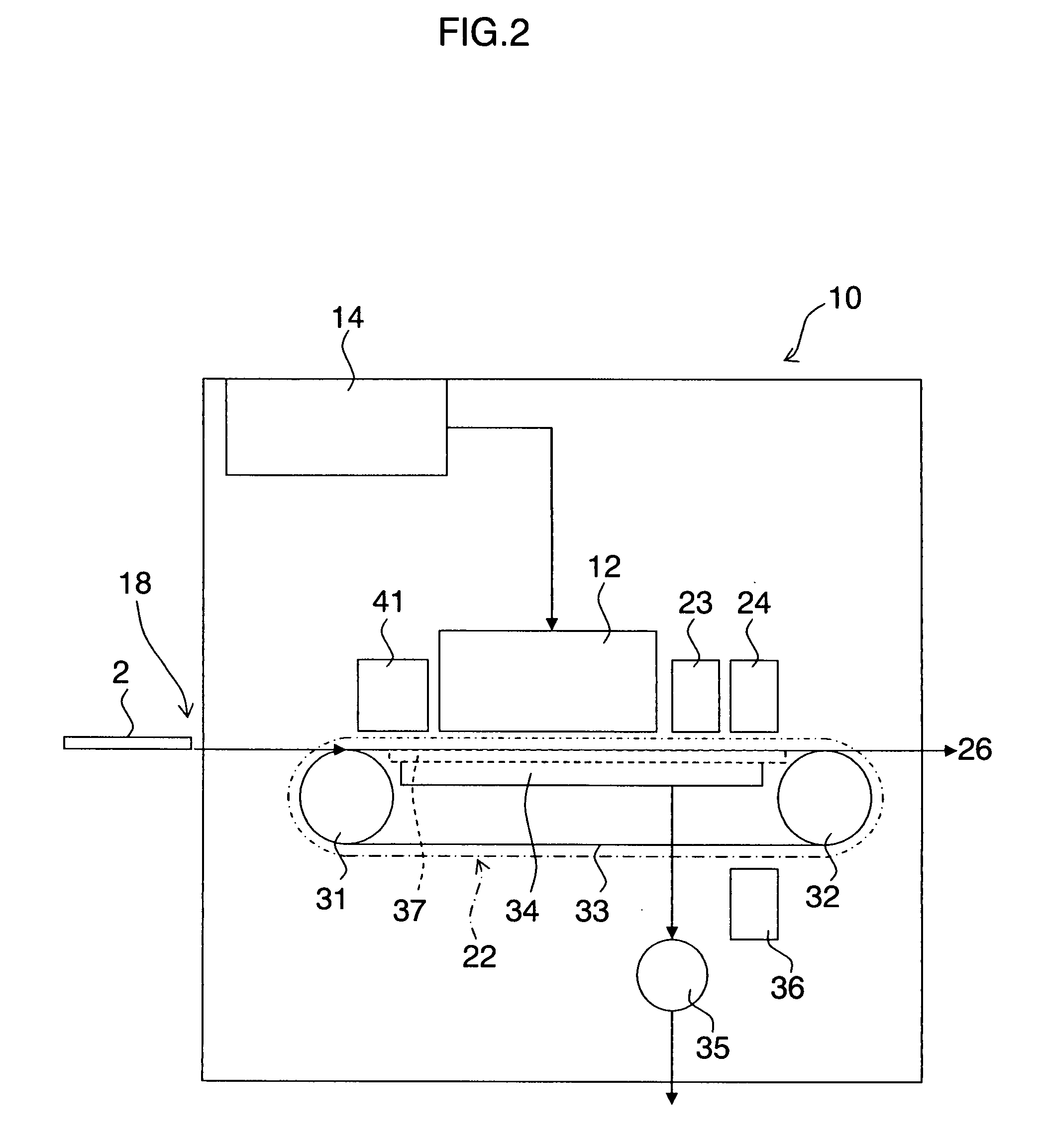Liquid ejection apparatus and resist pattern forming method
a technology of resist pattern and liquid ejection, which is applied in the direction of coating, circuit masks, printing, etc., can solve the problems of high manufacturing cost, time and cost, and not necessarily advantageous for creating fine circuits
- Summary
- Abstract
- Description
- Claims
- Application Information
AI Technical Summary
Benefits of technology
Problems solved by technology
Method used
Image
Examples
first embodiment
General Composition of Jet Recording Apparatus (Liquid Ejection Apparatus)
[0060]FIG. 2 is a diagram of the general composition of an inkjet (liquid jet) recording apparatus (liquid ejection apparatus) relating to an embodiment of the present invention. In the liquid-jet recording apparatus 10 according to the present embodiment of the invention, a resist layer 5 having a prescribed pattern as well as a prescribed thickness can be formed on the substrate 2 formed with a copper foil layer 3 (3′) (see FIGS. 1A and 1N) and the insulating substrate 1 (see FIG. 1I), by means of resist liquid.
[0061]The liquid-jet recording apparatus 10 shown in FIG. 2 comprises: a head 12 which ejects resist liquid; a resist liquid storing and accumulating unit 14 which stores the resist liquid to be supplied to the head 12; a supply unit 18 which supplies a substrate 2 (which may be a substrate formed with a copper foil layer or an insulating substrate on which a copper foil layer has not been formed); a ...
second embodiment
[0136]Next, a second embodiment of the present invention is described below. FIG. 9A is a plan diagram showing the nozzle arrangement in a head 120 relating to the second embodiment of the present invention. In the second embodiment described below, items which are the same as or similar to those in the first embodiment described above are labeled with the same or similar reference numerals and description thereof is omitted here.
[0137]The head 120 shown in FIG. 9A has the same nozzle arrangement as the head 12 having the arrangement shown in FIG. 4A, and it is a full line head in which a plurality of nozzles are aligned through a length of the substrate 2 corresponding to the main scanning direction, which is the breadthways direction of the substrate 2 (see FIG. 3), and ten nozzles (a number of nozzles corresponding to the maximum number of accumulated layers of resist liquid) are arranged equidistantly at an arrangement pitch of Pns in the sub-scanning direction, which is the dir...
modification example 1
[0164]Next, a modification example of the present invention is described below. FIG. 13 is a general schematic drawing of a liquid-jet recording apparatus 200 relating to the present modification example. Similarly to the liquid-jet recording apparatus 10 described above, the liquid-jet recording apparatus 200 shown in FIG. 13 forms a resist layer having a desired thickness (see FIGS. 1A to 1R) onto a substrate 2, by accumulating layers of resist liquid ejected onto the substrate 2. In the present modification example, the breadthways direction of the substrate 2 (in other words, the direction in which the head 202 moves with respect to the fixed substrate 2) is taken to be the main scanning direction, and the direction in which the substrate 2 is moved with respect to the head 202 is taken as the sub-scanning direction.
[0165]The print unit 204 comprises a carriage 208 which is movable reciprocally along two guide rails 206 extending in the main scanning direction, which is the brea...
PUM
 Login to View More
Login to View More Abstract
Description
Claims
Application Information
 Login to View More
Login to View More - R&D
- Intellectual Property
- Life Sciences
- Materials
- Tech Scout
- Unparalleled Data Quality
- Higher Quality Content
- 60% Fewer Hallucinations
Browse by: Latest US Patents, China's latest patents, Technical Efficacy Thesaurus, Application Domain, Technology Topic, Popular Technical Reports.
© 2025 PatSnap. All rights reserved.Legal|Privacy policy|Modern Slavery Act Transparency Statement|Sitemap|About US| Contact US: help@patsnap.com



